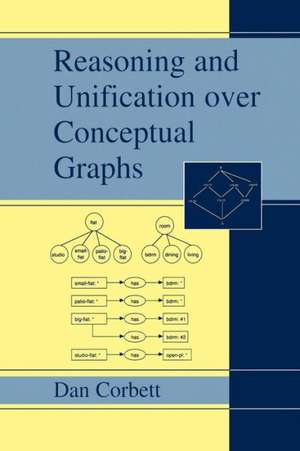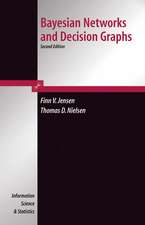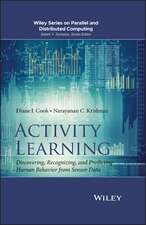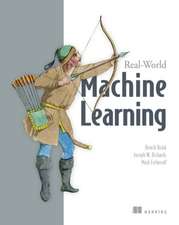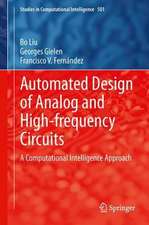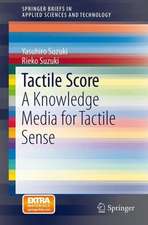Reasoning and Unification over Conceptual Graphs
Autor Dan Corbetten Limba Engleză Paperback – 17 sep 2012
| Toate formatele și edițiile | Preț | Express |
|---|---|---|
| Paperback (1) | 639.20 lei 6-8 săpt. | |
| Springer Us – 17 sep 2012 | 639.20 lei 6-8 săpt. | |
| Hardback (1) | 644.66 lei 6-8 săpt. | |
| Springer Us – 31 ian 2003 | 644.66 lei 6-8 săpt. |
Preț: 639.20 lei
Preț vechi: 799.00 lei
-20% Nou
Puncte Express: 959
Preț estimativ în valută:
122.32€ • 132.83$ • 102.75£
122.32€ • 132.83$ • 102.75£
Carte tipărită la comandă
Livrare economică 22 aprilie-06 mai
Preluare comenzi: 021 569.72.76
Specificații
ISBN-13: 9781461349174
ISBN-10: 1461349176
Pagini: 168
Ilustrații: X, 151 p.
Dimensiuni: 155 x 235 x 9 mm
Greutate: 0.25 kg
Ediția:Softcover reprint of the original 1st ed. 2003
Editura: Springer Us
Colecția Springer
Locul publicării:New York, NY, United States
ISBN-10: 1461349176
Pagini: 168
Ilustrații: X, 151 p.
Dimensiuni: 155 x 235 x 9 mm
Greutate: 0.25 kg
Ediția:Softcover reprint of the original 1st ed. 2003
Editura: Springer Us
Colecția Springer
Locul publicării:New York, NY, United States
Public țintă
ResearchCuprins
1 Conceptual Structures.- 1.Introduction.- 2. Overview.- 3. Conceptual Graphs: What They Are and How They Work.- 4. Previous Work in Constraints and Unification over Conceptual Graphs.- 5. Summary.- 2 Unification, Knowledge Structures and Constraints.- 1. Introduction.- 2. Unification.- 3. Feature Structures.- 4. Logic Programming, Constraint Logic Programming, and Constraint Satisfaction Problems.- 5. Unification and Constraints.- 6. Knowledge Structures, Partialness and Unification.- 7. Summary.- 3 An Algorithm for the Unification of Conceptual Graphs with Constraints.- 1. Introduction.- 2. Interval constraints.- 3. Projection and constraints using intervals.- 4. Unification over constraints.- 5. Unification Algorithm.- 6. Summary.- 4 Results, Demonstrations and Comparisons.- 1. Introduction.- 2. Design.- 3. Experiments: Simple Structures.- 4. Experiments: Difficult Structures and Unification Failures.- 5. Comparisons to Other Systems.- 6. Summary.- 5 Placing the Unification Model inContext.- 1. Introduction.- 2. A Framework of Unification Methods.- 3. A Toolbox for Knowledge Conjunction on Conceptual Graphs.- 4. Extending the Model.- 5. Summary.- 6 Conclusions and Future Work.- 1. Conclusions.- 2. Future Directions.- References.
Recenzii
From the reviews:
"Reasoning and Unification over Conceptual Graphs addresses two main issues: The first one is application of numerical constraints to the values of concepts in a Conceptual Graph, and the second is unification of Conceptual Graphs in general, and constrained ones in particular. … If you are a researcher in the Conceptual Graph community … this book will be of interest to you. Researchers who are looking into the unification problem in other knowledge representation domains may also benefit from it." (Gilad Mishne, Journal of Logic, Language and Information, Vol. 14, 2005)
"Reasoning and Unification over Conceptual Graphs addresses two main issues: The first one is application of numerical constraints to the values of concepts in a Conceptual Graph, and the second is unification of Conceptual Graphs in general, and constrained ones in particular. … If you are a researcher in the Conceptual Graph community … this book will be of interest to you. Researchers who are looking into the unification problem in other knowledge representation domains may also benefit from it." (Gilad Mishne, Journal of Logic, Language and Information, Vol. 14, 2005)
